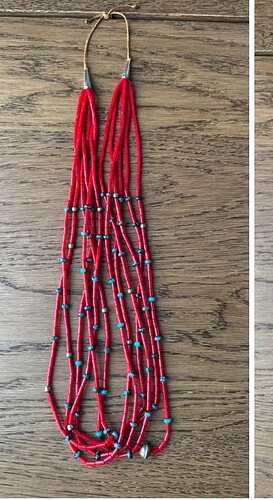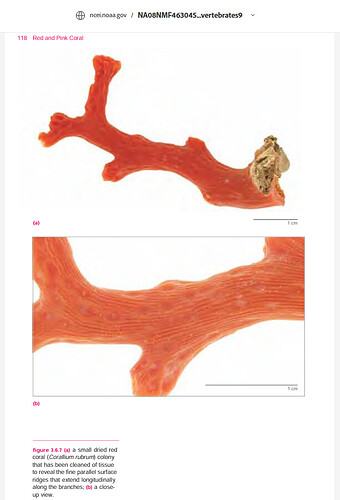Hi - I purchased this necklace from someone in Canada who said it was gifted to her by a great uncle that used to perform on a nearby reservation. She called the red beads “coral” but upon closer inspection they feel/look like they are something like glass. Any thoughts on what the red beads might be? Also, if you have any knowledge of the string that it’s strung on (possibly waxed) - is that traditional? Any chance it is, in fact, vintage?Thank you.
Hi there! we’d need a much closer view of the red beads to determine of they are genuine coral. I have several strands of coral tube beads similar to this. You can often tell by the presence of lines or “veins” that align with the length of the beads, and occasionally what looks like pores. Glass is definitely used as a low cost substitute.
(https://www.ncei.noaa.gov/data/oceans/coris/library/NOAA/CRCP/other/grants/NA08NMF4630456_traffic_species_invertebrates9.pdf) ← this article is a great source of info on other corals that are used to substitute for real mediterranean branch coral)
Yes, the waxed looking twine is common for stringing beads like these.
by the way, this is a fantastic looking necklace, i would wear proudly regardless.
Thank you for taking the time to respond and for including the article. There are no lines or veins - the beads are very smooth. I’m going to assume they are glass or another material that is noted in the article.
A closer in more in focus image would help, from first look it appears to be dyed bamboo coral. Here is a link to some sold at Thunderbird. 4mm Heishi Bamboo Coral - Thunderbird Supply Company - Jewelry Making Supplies
Very pretty necklace. Did you use a loupe to check the coral. The photo is not a close enough shot to be able to see. The polished coral tube bead necklace that I have is very smooth to the touch and there aren’t obviously visible “lines”. However, under a loupe you can see the striations in the coral.
Agree that the beads are dyed material vs. natural.

